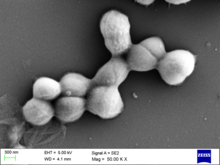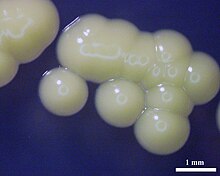| Micrococcus luteus | |
|---|---|

| |
| Scientific classification | |
| Domain: | Bacteria |
| Phylum: | Actinomycetota |
| Class: | Actinomycetia |
| Order: | Micrococcales |
| Family: | Micrococcaceae |
| Genus: | Micrococcus |
| Species: | M. luteus
|
| Binomial name | |
| Micrococcus luteus (Schroeter 1872)
Cohn 1872 | |
Micrococcus luteus is a Gram-positive to Gram-variable, nonmotile, tetrad-arranging, pigmented, saprotrophic coccus bacterium in the family Micrococcaceae.[1] It is urease and catalase positive. An obligate aerobe, M. luteus is found in soil, dust, water and air, and as part of the normal microbiota of the mammalian skin. The bacterium also colonizes the human mouth, mucosae, oropharynx and upper respiratory tract.
Micrococcus luteus is generally harmless but can become an opportunistic pathogen in immunocompromised people or those with indwelling catheters.[2] It resists antibiotic treatment by slowing of major metabolic processes and induction of unique genes.[citation needed] Its genome has a high G + C content.
Micrococcus luteus is coagulase negative, bacitracin susceptible, and forms bright yellow colonies on nutrient agar.
Micrococcus luteus has been shown to survive in oligotrophic environments for extended periods of time. It has survived for at least 34,000 to 170,000 years, as assessed by 16S rRNA analysis, and possibly much longer.[3] Its genome was sequenced in 2010 and is one of the smallest genomes of free-living Actinomycetota sequenced to date, comprising a single circular chromosome of 2,501,097 bp.[4]
- ^ Madigan M; Martinko J, eds. (2005). Brock Biology of Microorganisms (11th ed.). Prentice Hall. ISBN 978-0-13-144329-7.
- ^ Canada, Public Health Agency of (19 April 2011). "Pathogen Safety Data Sheets: Infectious Substances – Micrococcus spp". www.canada.ca. Retrieved 5 January 2023.
- ^ Greenblatt, C.L.; Baum, J.; Klein, B.Y.; Nachshon, S.; Koltunov, V.; Cano, R.J. (2004). "Micrococcus luteus – Survival in Amber". Microbial Ecology. 48 (1): 120–127. doi:10.1007/s00248-003-2016-5. PMID 15164240. S2CID 24070772.
- ^ Young M, Artsatbanov V, Beller HR, Chandra G, Chater KF, Dover LG, Goh EB, Kahan T, Kaprelyants AS, Kyrpides N, Lapidus A, Lowry SR, Lykidis A, Mahillon J, Markowitz V, Mavromatis K, Mukamolova GV, Oren A, Rokem JS, Smith MC, Young DI, Greenblatt CL (2010). "Genome sequence of the Fleming strain of Micrococcus luteus, a simple free-living actinobacterium". Journal of Bacteriology. 192 (3): 841–860. doi:10.1128/JB.01254-09. PMC 2812450. PMID 19948807.
